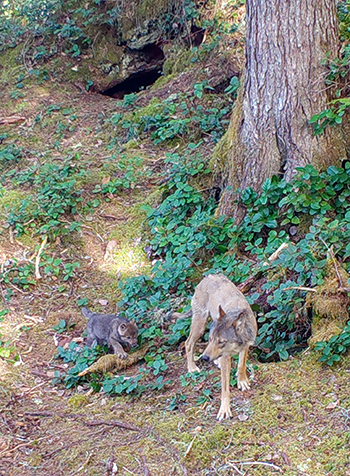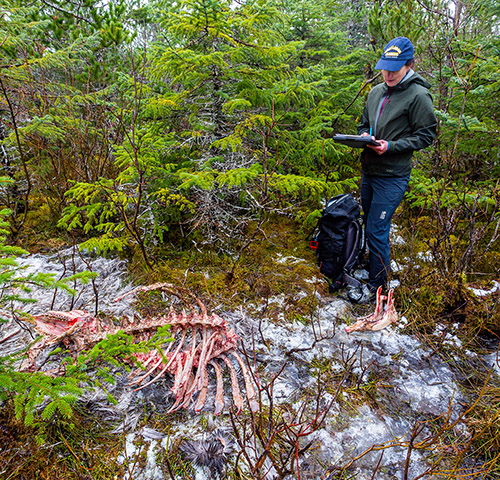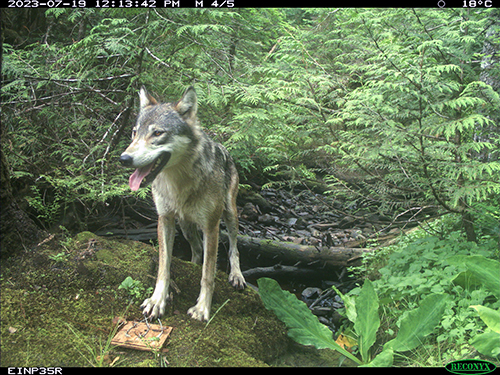Alaska Fish & Wildlife News
June 2025
Wolves with too much in common
Island wolves breed with close relatives

Few wolves are swimming to Prince of Wales Island from other islands or the mainland. New research found this wolf population on Prince of Wales Island (POW), at the southern end of the Southeast Alaska Panhandle, has limited genetic connectivity with neighboring populations and has high levels of inbreeding.
These results come from a research project that collected genetic data — samples of muscle tissue — from wolves across the archipelago from 2002-2016. Out of the samples collected, those from Prince of Wales Island showed wolves there had bred most with close relatives. Lead researcher, Gretchen Roffler, a biologist with the Alaska Department of Fish and Game, said she wasn’t surprised by the results, noting that the entire region of Southeast Alaska is isolated.
“All the other genetic research that has been done has shown that Prince of Wales Island is the most genetically distinct. I was not surprised that our research showed the same thing essentially,” Roffler said. “Because of that isolation, we would expect that close relatives would be mating.”
Roffler’s research also echoed past findings — there isn’t a lot of gene flow onto the island.
Inbreeding is bad

It’s no secret that inbreeding is bad. But beyond the creepy feeling the word elicits, genetically there are important reasons why diversity helps animal populations thrive.
In healthy populations of wolves that have geographic connectivity to other populations, there is ample opportunity for interactions with others and maintaining genetic diversity. In such populations, less ideal characteristics, those that would inhibit survival, are either bred out of the population or remain masked due to dominant genes. This is good.
But in populations that are isolated, wolves have fewer mating opportunities with unrelated wolves. Prolonged or extensive inbreeding can result in inbreeding depression which can result in negative characteristics that would get masked in larger, more diverse populations. Some symptoms of inbreeding depression include lower reproduction, smaller wolf litter size and lower pup survival. Other signs are things like deformities, often of the lower vertebrae. Sometimes, one or both testes will not descend, making the male sterile. Other times, the teeth will not align properly. This inhibits the animal’s fitness, and as the population begin to shrink, the inbreeding compounds. This is bad.
Understanding the POW problem

Roffler’s research found that dispersal throughout POW and the adjacent islands of the region (known as Game Management Unit 2 or GMU 2) happens frequently and has been documented through monitoring GPS collared wolves and using genetic recapture data. However, none of the GPS collared wolves have been documented traveling the three- to seven-kilometer distance between GMU 2 and other GMUs.
Genetic findings echoed this data. One of the sampled wolves showed it was closely related to other wolves in Southeast, suggesting it has an ancestor that immigrated to POW from elsewhere in the region. This result underscores that using genetic sampling can reveal hard to detect events like long-distance dispersal. However, after over more than a decade of monitoring, this was the only wolf identified from outside the system that traveled to POW.
So how inbred are the wolves on POW?
POW wolves had the highest levels of inbreeding in comparison to wolves in other parts of Southeast Alaska. Wolves in the northern end of Lynn canal on the mainland had the lowest levels, and wolves in GMUs 1A, 1B, and 3, were inbred, although less extensively than GMU 2 wolves.

Roffler said more research is needed to figure out the next steps when it comes to management of wolves on POW. “Additional work is necessary to understand whether the observed low genetic variation and high individual inbreeding represent significant risks to the long-term persistence of populations,” Roffler wrote in a recent paper, currently under peer-review, “and whether management actions like the translocation of individuals would be beneficial.”
Translocation efforts are risky and must be well-researched. For now, low genetic variation and high individual inbreeding estimates on POW highlight the need to understand if the population is, in fact, facing inbreeding depression before any strategies are enacted.
“It’s very hard to predict,” Roffler said. “because of individual variation and the random nature of genetic recombination.”
Subscribe to be notified about new issues
Receive a monthly notice about new issues and articles.
